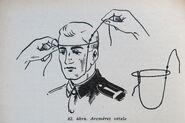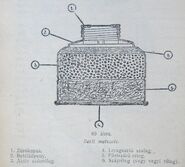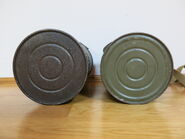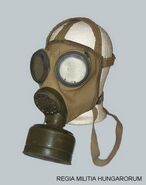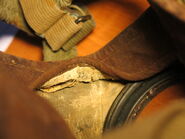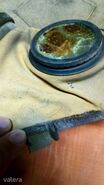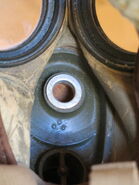The Hungarian 34M was designed before the Second World War and was used until the end of the 1990s in some form. Originally it was issued to the Magyar Királyi Honvédség (Hungarian Royal Army), Légoltalmi Liga (predecessor of the Polgári védelem - Civil Defence) after the war to the Magyar Néphadsereg (Hungarian People’s Army) later it was also used by the Polgári védelem (Civil Defence).
Overview
It is a full face mask made of rubber-coated light brown canvas (darker or greener canvas was used as well and some Post-War models uses the 67M styled green canvas) and seals on the face via goat leather verge. The shatterproof (it is composed of two glass layers and a thin sheet of cellulose between) glasses are crimped to copper assemblies which are pressed to the faceblank permanently. The harness uses a three-piece adjustable harness hooked up to a small leather center-piece the straps are bolted onto, an additional strap near the bottom would be wrapped around the user's head and hooked around to provide a tight seal. There is a carrying strap on the bottom back of the mask. The valves are in one dark olive green painted aluminium alloy piece. The "tulip" styled exhale valve is on top of the 40mm intake (the thread is very loose, GOST filters can easily fit in and seal with the mask) covered with a threaded grid. Unlike the Cold War Hungarian masks, the size 1 is the biggest and size 4 is the smallest.
Filter
Main article: 34M and 41M filters
The 34M filter comes in a cylindrical canister with a cap and sticker sealing the bottom. The filter was redeveloped in 1941 hence the new designation is 41M.
Carriers and kit
Bag
The 34M bag is made of canvas with a leather bottom. The little pocket under the lid is for the spare antifog inserts. The early bags have rivets on the top corner of the pocket.
Canisters
The first canister used with the mask is called "Fém horddoboz" (Metal carrying case). It was used with the mask since before the war by Légoltalmi Liga and other civil defence workers.
Later the canvas bag was changed to the 42M metal cylindrical box inlined with cardboard (very similar to the German ones). It has a metal frame on the inside lid which is for the antifog inserts but sometimes the Gázseb-csomag (Gas wound kit - decontamination kit) was stored there as well. It is believed that the 42M is the copy of the Yugoslav M-33 canister. Because Hungary helped Germany in the invasion of Yugoslavia (1941), hence Délvidék (now part of Serbia) became Hungarian territory again. The war booty contained masks too which were given to Légoltalmi Liga. And the M-33 canister is very similar to the not much later 42M making the speculations quite valid.
The kit contained:
- 34M facepiece
- 34M filter
- 34M bag or 42M cylinder box
- antifog inserts (or later soap)
Variants
Telling the era of the mask is the easiest from the painting, but it is not a sure method because after the war the useable masks were re-issued with a new coat of paint. Using the stamps and other markings is not the best way either because like the painting after the war masks in good condition were reissued with new markings. So it can occur that a mask that was made before the war has communist markings and "Tildy" green eyepieces. Masks with a serial number on the forehead part under the sealing leather part were made before or during the war.
Pre-war and war models
Army
The war production masks have dark olive-brown colored aluminium valve houses and eyepiece assemblies and other metal parts are made of black painted copper, these metals are non-magnetic. The sealing leather is brown and the intake sealing ring is natural beige colored. The 42M carrying canisters are light brown (soldier slang for the color called it liba - "goose") colored not green and always has a metal hook to fix the box to the belt.
Fire brigade
The pre-war fire brigade variant, called T. gázálarc or 33M tűzoltóálarc (not to confuse with the 33M), had a flatter exhale valve cover and a bit different valve housing, otherwise, the mask was identical to the army variant. It was used with 28M filter, German-made CO filters and Mercur T. gázálarc filter and hose.
Civilian
The Civil defence variants, called M. gázálarc, have unpainted raw copper eyepiece assemblies and came in the 34M bag or 42M "hópihe" canister.
Rebreather
This variant is identical to the civilian but was modified to use with rebreathers. The older type valve house was used, the exhale valve was removed and the hole was sealed. The inhale valve was removed then the valve fixing part was drilled through to mount the oral-nasal cup clamper ring with a screw.
Post-war models
The post-war variants are much more diverse. Overall it can be said that the sealing rubber ring on the intake valve is black on the post-war used ones and the sealing leather is light brown or white. But small differences on the post-war models can occur like a mix of pre and post-war metal parts.
Military and Civil Defence
On the early ones every metal parts (valve housing, eyepiece assemblies, filter, carrying canister) are painted green (or the very early ones has the light brown color). And to reduce costs steel alloy (magnetic) was used instead of copper (non-magnetic) which is expensive.
Industry
Called Ipari gázálarc, it has mostly black rubber inside and sometimes come in the dark green colored canvas on the outside. Sometimes it lacks painted metal parts which are mostly aluminium and steel alloy. But the matte black or green painted metal parts are much more common. Later it was succeeded by Ipari teljes álarc.
External information
Development
The development started around the same time, in 1933, as the 33M and it came out just after. The first model was the T. gázálarc it was fine for the fire brigade but the lid of the exhale valve could not be screwed off easily and the valve house was not so easy to manufacture, replacing the exhale valve also required a special tool. The new lid, came out in 1934, gave more place for the exhale valve so the valve housing was redesigned a bit to make easier to manufacture but the exhale valve still hade a funnel where it could sit. Around 1939-1940 the valve got redesigned again. This time the funnel was removed and other structural changes were also applied making the new housing easier, faster and cheaper to manufacture.
Price
- The 34M kit costed 25 Pengő (the mask was 14 Pengő) in 1936 which is nothing compared to the original price of the 28M whit its 113 Pengő price (the Népgázálarc was 13 Pengő).
- The M. gázálarc kit costed 23 Pengő with bag; 18,50 Pengő with cardboard carrier.
- The T. gázálarc kit costed 45 Pengő.
Manufacturers
Before and during the war the facepiece, bag and filter were made by Mercur Műszaki és Vegyipari Rt. in Budapest, the average production was 100000 gas masks in a year and 500000 filters per month (this number includes Népgázálarc as well). The activated charcoal was provided by IPTER Műszéntermelő Vállalat, the rubber-coated canvas was made by Ruggyantaárugyár and the canvas for the bag was manufactured by Szegedi Len- és Kendergyár. Ony the antifog inserts were made abroad by Auer in Berlin. Just after the war, nothing changed but after the communist takeover Mercur was renamed to 1004. sz. Vállalat (1951) and later to Műszaki Művek (1952) and Medicor (1963).
Service
- Fire brigade (1934-1960s): Used T. gázálarc and M. gázálarc before and during the war. After the war, the 34M (mainly post-war models) was issued.
- Magyar Királyi Honvédség (Hungarian Royal Army) (1936-1945): The standard-issue gas mask for the army. The army was issued with 43M Gázvédő lepel (gas protective perianth) and the chemical troops used the mask with 37M Gázvédőruha (gas protection suit).
- Légoltalmi liga (Civil Defence) (1935-1945): The Civil Defence used the mask as M. gázálarc, it was issued to active members and clean up crews alongside with the Gumi munkagázálarc .
- Magyar Honvédség (Hungarian army) (1946-1951): The mask was again the standard-issue gas mask for the army alongside with the post-war models. The chemical troops used it with the same chemical suit as in the war. In 1949 there were 87639 pcs. in stock.
- Polgári védelem (Civil Defence) (1946-1967): Gas mask for registered members.
- Magyar Néphadsereg (Hungarian People's Army) (1951-1953): After the short-lived democratic army and the communist takeover the army was renamed and a lot of things changed but the mask was in service until 1955 (til enough 51M masks were made).
- The industry used post-war models until the 1960s with industrial filters, fresh air breathing devices and supplied fresh air devices. The factory based emergency firefighter warehouses stored the model even before the regime change.
Other pictures
References
- Légoltalmi radiológiai-biológiai-vegyvédelmi alapismeretek (book-1965)
- Légoltalmi ismeretek a lakóházi (önvédelmi) szervek részére II. kiadás (book-1952)
- Horler Ferenc: A polgári lakosság önvédelme légitámadások ellen (book-1938)
- Légoltalmi ABC (book-1939)
- Magyar atom-, biológiai- és vegyi- (ABV) védelmi technikai almanch (2003)
- Légoltalmi ismeretek (book-1937)
- http://militiahungarorum.roncskutatas.com/1920_e_f_g_4.html
- http://gasmask1.kalasnyikov.hu/masks/m34/m34.htm#M%C3%A1sodik%20vil%C3%A1gh%C3%A1bor%C3%BA%20ut%C3%A1ni%20v%C3%A1ltozat
- http://www.fortepan.hu/?search=g%C3%A1z%C3%A1larc
- https://drive.google.com/file/d/1XOoEz8_g2QLq6zZ9FSq8Q3uEEAi2vQOG/view
- http://maski.poszukiwania.pl/index.php/en/wegry
- https://drive.google.com/file/d/0B2IT5sLzLGdDeUdtM3pGVzFfS0E/view




